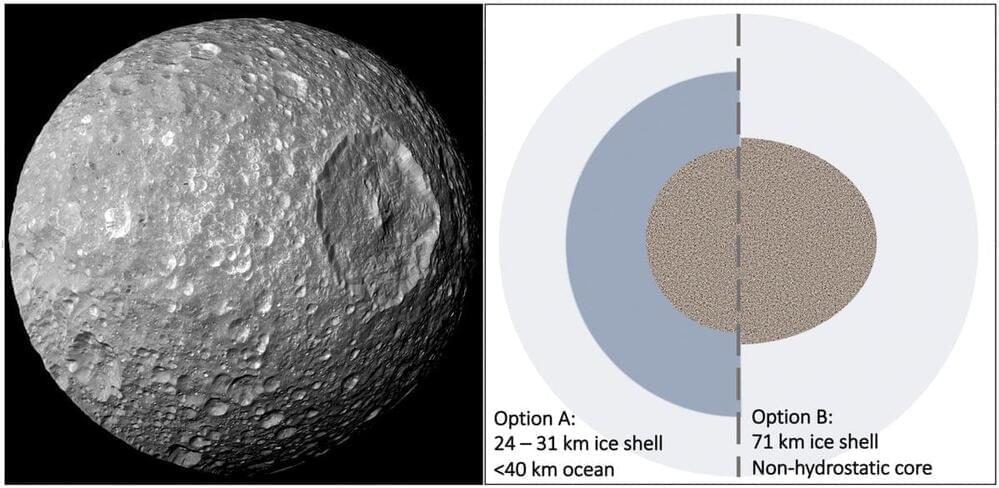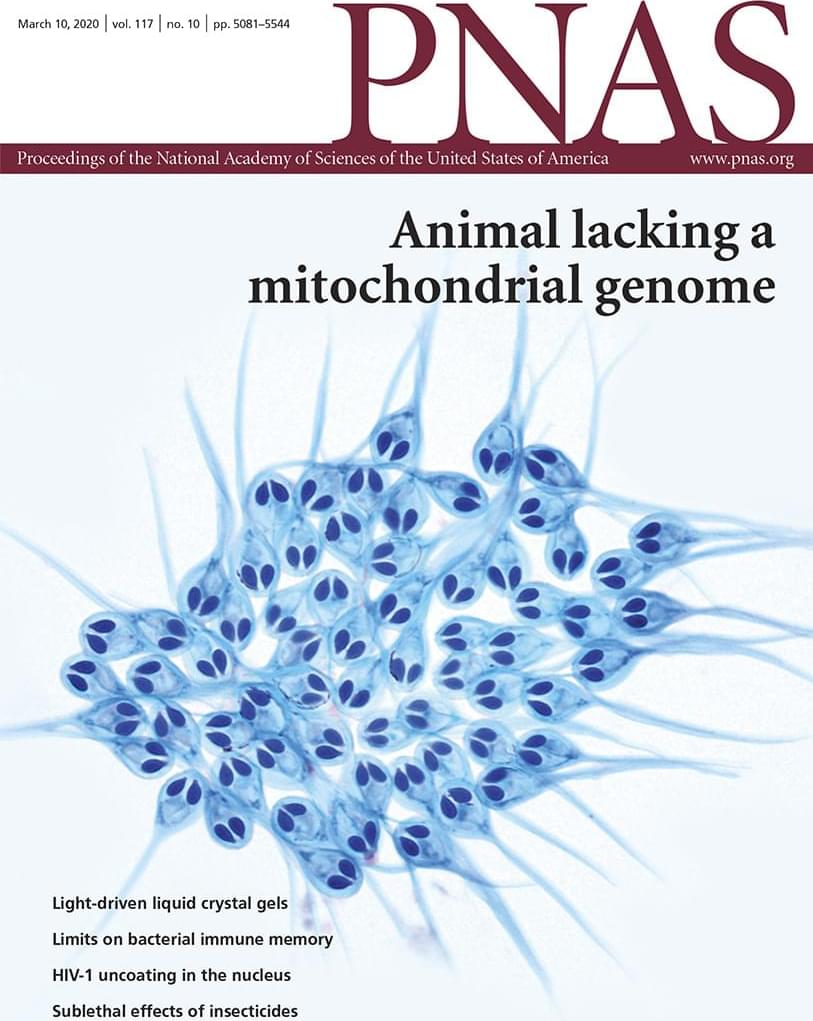If Mimas has an ocean, it represents a new class of small, ‘stealth’ ocean worlds with surfaces that do not betray the ocean’s existence.



𝐑𝐞𝐬𝐞𝐚𝐫𝐜𝐡𝐞𝐫𝐬 𝐚𝐭 𝐍𝐚𝐠𝐨𝐲𝐚 𝐔𝐧𝐢𝐯𝐞𝐫𝐬𝐢𝐭𝐲 𝐢𝐧 𝐉𝐚𝐩𝐚𝐧 𝐡𝐚𝐯𝐞 𝐮𝐬𝐞𝐝 𝐚 𝐧𝐞𝐰 𝐝𝐞𝐯𝐢𝐜𝐞 𝐭𝐨 𝐢𝐝𝐞𝐧𝐭𝐢𝐟𝐲 𝐚 𝐤𝐞𝐲 𝐦𝐞𝐦𝐛𝐫𝐚𝐧𝐞 𝐩𝐫𝐨𝐭𝐞𝐢𝐧 𝐢𝐧 𝐮𝐫𝐢𝐧𝐞 𝐭𝐡𝐚𝐭 𝐢𝐧𝐝𝐢𝐜𝐚𝐭𝐞𝐬 𝐰𝐡𝐞𝐭𝐡𝐞𝐫 𝐭𝐡𝐞 𝐩𝐚𝐭𝐢𝐞𝐧𝐭 𝐡𝐚𝐬 𝐚 𝐛𝐫𝐚𝐢𝐧 𝐭𝐮𝐦𝐨𝐫. 𝐓𝐡𝐢𝐬 𝐩𝐫𝐨𝐭𝐞𝐢𝐧 𝐜𝐨𝐮𝐥𝐝 𝐛𝐞 𝐮𝐬𝐞𝐝 𝐭𝐨 𝐝𝐞𝐭𝐞𝐜𝐭 𝐛𝐫𝐚𝐢𝐧 𝐜𝐚𝐧𝐜𝐞𝐫, 𝐚𝐯𝐨𝐢𝐝𝐢𝐧𝐠 𝐭𝐡𝐞 𝐧𝐞𝐞𝐝 𝐟𝐨𝐫 𝐢𝐧𝐯𝐚𝐬𝐢𝐯𝐞 𝐭𝐞𝐬𝐭𝐬, 𝐚𝐧𝐝 𝐢𝐧𝐜𝐫𝐞𝐚𝐬𝐢𝐧𝐠 𝐭𝐡𝐞 𝐥𝐢𝐤𝐞𝐥𝐢𝐡𝐨𝐨𝐝 𝐨𝐟 𝐭𝐮𝐦𝐨𝐫𝐬 𝐛𝐞𝐢𝐧𝐠 𝐝𝐞𝐭𝐞𝐜𝐭𝐞𝐝 𝐞𝐚𝐫𝐥𝐲 𝐞𝐧𝐨𝐮𝐠𝐡 𝐟𝐨𝐫 𝐬𝐮𝐫𝐠𝐞𝐫𝐲. 𝐓𝐡𝐢𝐬 𝐫𝐞𝐬𝐞𝐚𝐫𝐜𝐡 𝐜𝐨𝐮𝐥𝐝 𝐚𝐥𝐬𝐨 𝐡𝐚𝐯𝐞 𝐩𝐨𝐭𝐞𝐧𝐭𝐢𝐚𝐥 𝐢𝐦𝐩𝐥𝐢𝐜𝐚𝐭𝐢𝐨𝐧𝐬 𝐟𝐨𝐫 𝐝𝐞𝐭𝐞𝐜𝐭𝐢𝐧𝐠 𝐨𝐭𝐡𝐞𝐫 𝐭𝐲𝐩𝐞𝐬 𝐨𝐟 𝐜𝐚𝐧𝐜𝐞𝐫. 𝐓𝐡𝐞 𝐫𝐞𝐬𝐞𝐚𝐫𝐜𝐡 𝐰𝐚𝐬 𝐩𝐮𝐛𝐥𝐢𝐬𝐡𝐞𝐝 𝐢𝐧 𝐀𝐂𝐒 𝐍𝐚𝐧𝐨.
Although early detection of many types of cancer has contributed to the recent increases in cancer survival rates, the survival rate for brain tumors has remained almost unchanged for over 20 years. Partly this is due to their late detection. Physicians often discover brain tumors only after the onset of neurological symptoms, such as loss of movement or speech, by which time the tumor has reached a considerable size. Detecting the tumor when it is still small, and starting treatment as soon as possible, should help to save lives.
One possible sign that a person has a brain tumor is the presence of tumor-related extracellular vesicles (EVs) in their urine. EVs are nano-sized vesicles involved in a variety of functions, including cell-to-cell communication. Because those found in brain cancer patients have specific types of RNA and membrane proteins, they could be used to detect the presence of cancer and its progression.

Elon Musk said Twitter will introduce an early version of a long-teased new feature on the platform allowing creators to be paid for their tweets as soon as next week.
Musk responded to a tweet on Tuesday by a user who said Twitter’s co-tweet feature which lets users co-author tweets together is “stupid af” to which Musk responded: “You’re welcome. Axed them yesterday to focus on enabling writers to add essays as attachments to tweets.
Combined with improvements to creator subscriptions (fka superfollow), you will be able to publish directly on Twitter & get paid for it.
This is more about the current landscape but a bit on the future near the beginning.
In this video Dr de Grey talks the future of LEVF and how the longevity field has evolved and some of the main participants.
Dr. Aubrey de Grey is internationally recognised as the visionary biomedical gerontologist who devised the Strategies for Engineered Negligible Senescence: a comprehensive set of methods to rejuvenate the human body, thereby preventing age-related ill health and mortality. He has co-founded multiple non-profit organizations – including Methuselah Foundation, SENS Research Foundation, and LEV Foundation – to enable and accelerate its development and clinical translation.
The Longevity Escape Velocity Foundation.
_https://www.levf.org/_
*Renue By Science* 10% : _https://tinyurl.com/4yrf4tv3_

Feature image credits: Memorial Sloan Kettering Cancer Center
It was a life-changing day for 12 patients living in the United States when they found that their cancer had vanished, thanks to a small clinical trial. Of the total number of patients, these were the patients who completed the trial.
The New York Times reported that a drug named Dostarlimab was administered to these patients — all suffering from rectal cancer — over six months. All 12 patients entered remission after the period.
Google’s competitor to OpenAI’s ChatGPT may appear as soon as next week. The company will hold an event in Paris on Wednesday, Feb. 8, where it will discuss plans for its search engine.
The company isn’t revealing much about the event. The description merely says (Opens in a new window) : “We’re reimagining how people search for, explore and interact with information, making it more natural and intuitive than ever before to find what you need. Join us to learn how we’re opening up greater access to information for people everywhere, through Search, Maps, and beyond.”
It’s possible the event could focus more on Google’s conventional products, rather than AI. However, in an earnings call on Thursday, CEO Sundar Pichai said Google is preparing to unleash its AI programs to the public.

Year 2020 This type of parasite that feeds on salmon actually doesn’t need oxygen to live. Which means eventually there could be even gene editing that could essentially allow humans to not need as much air or could be independent of oxygen but only need anaerobic metabolisms perhaps. Really this can only expand our understanding of new ways to evolve humans to the next level.
Although aerobic respiration is a hallmark of eukaryotes, a few unicellular lineages, growing in hypoxic environments, have secondarily lost this ability. In the absence of oxygen, the mitochondria of these organisms have lost all or parts of their genomes and evolved into mitochondria-related organelles (MROs). There has been debate regarding the presence of MROs in animals. Using deep sequencing approaches, we discovered that a member of the Cnidaria, the myxozoan Henneguya salminicola, has no mitochondrial genome, and thus has lost the ability to perform aerobic cellular respiration. This indicates that these core eukaryotic features are not ubiquitous among animals. Our analyses suggest that H. salminicola lost not only its mitochondrial genome but also nearly all nuclear genes involved in transcription and replication of the mitochondrial genome. In contrast, we identified many genes that encode proteins involved in other mitochondrial pathways and determined that genes involved in aerobic respiration or mitochondrial DNA replication were either absent or present only as pseudogenes. As a control, we used the same sequencing and annotation methods to show that a closely related myxozoan, Myxobolus squamalis, has a mitochondrial genome. The molecular results are supported by fluorescence micrographs, which show the presence of mitochondrial DNA in M. squamalis, but not in H. salminicola. Our discovery confirms that adaptation to an anaerobic environment is not unique to single-celled eukaryotes, but has also evolved in a multicellular, parasitic animal. Hence, H. salminicola provides an opportunity for understanding the evolutionary transition from an aerobic to an exclusive anaerobic metabolism.
Year 2021 face_with_colon_three
For decades, scientists suspected that bacteria known as Geobacter could clean up radioactive uranium waste, but it wasn’t clear how the microbes did it.


Prasang Chandorkar was excited about turning a new leaf in his life after meeting Wachika on a matrimonial website. They soon got engaged and started planning their life ahead.
But little did they know what was in store for them. Soon after the engagement, in November 2021, Prasang was diagnosed with cancer. This brought his life to a standstill.